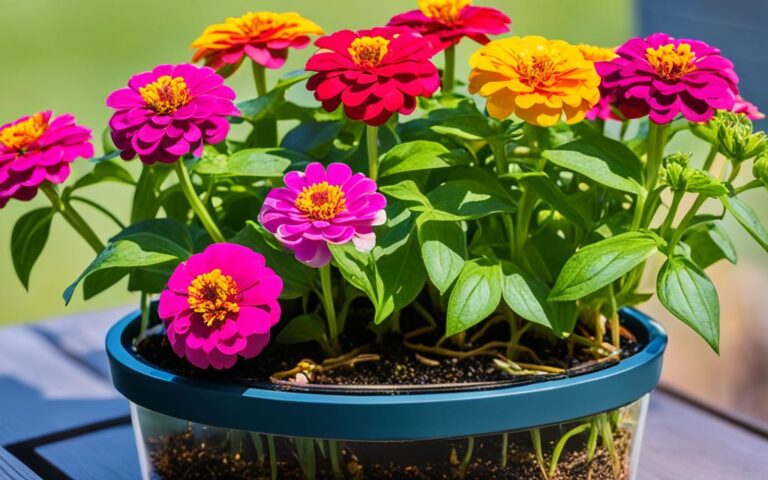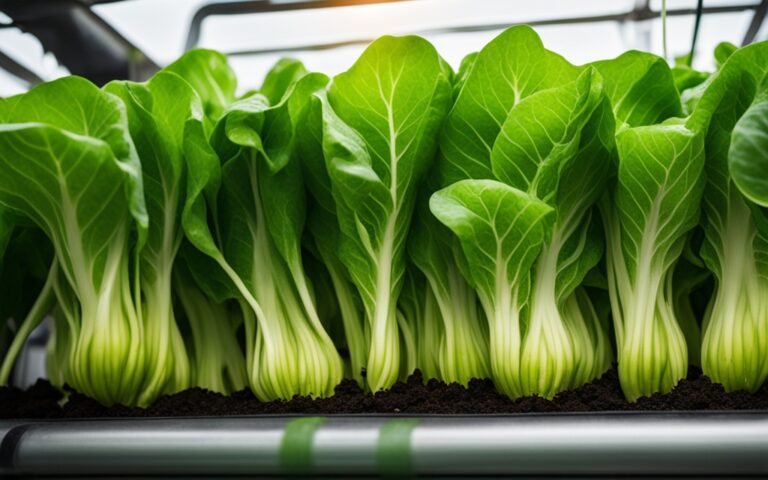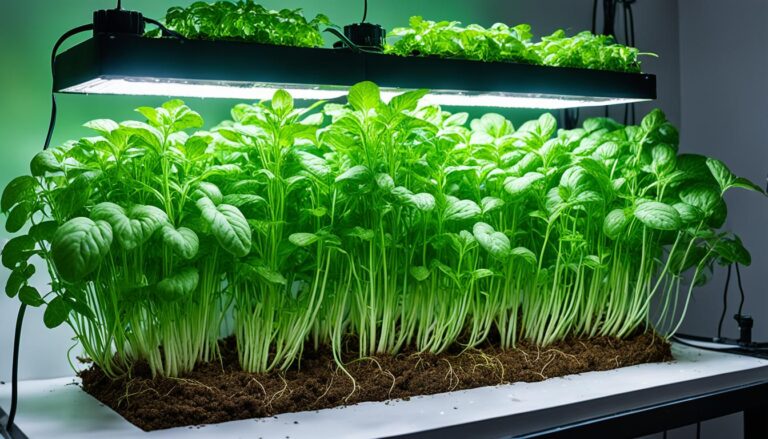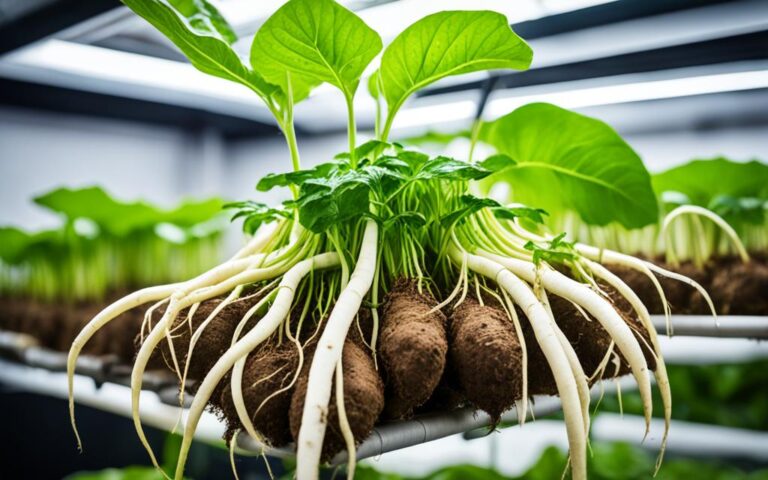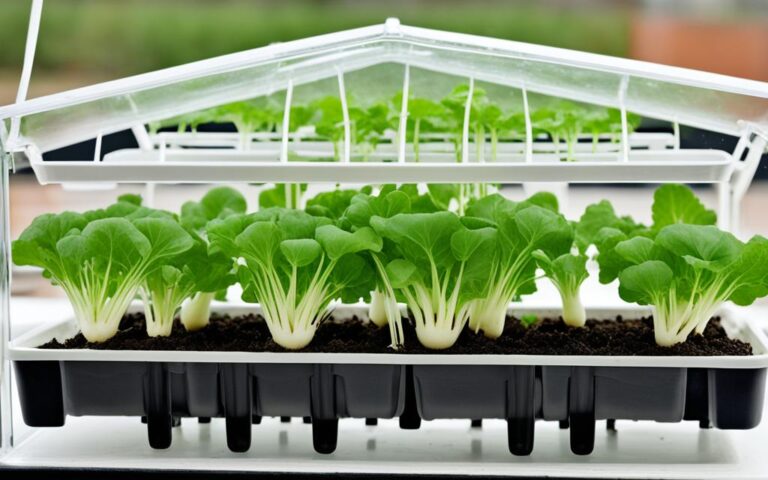Growing Hydroponic Blueberries: A Complete Guide
Blueberries are a favorite fruit that do well in hydroponic systems. They offer many benefits over growing in soil. This guide will cover the details of growing blueberries indoors, the perks of soil-less farming, and how controlled environment agriculture helps. It will also talk about getting the most out of blueberry plants through vertical farming and precision agriculture.
Growing blueberries hydroponically or in blueberry hydroculture lets growers create the perfect environment for these delicate fruits. By carefully controlling nutrients, pH, light, temperature, and humidity, growers can make sure their blueberries are top quality. This way, they can have a sustainable and controlled way to grow this superfruit.
Key Takeaways
- Hydroponic blueberry farming can result in faster growth and higher yields compared to traditional soil-based methods.
- Hydroponic systems provide greater control over environmental factors, reducing common issues like pests and diseases.
- Blueberries grown hydroponically require specific light, temperature, and humidity conditions for optimal growth.
- Maintaining the ideal pH range of 4.5 to 6.0 is crucial for the health and productivity of hydroponic blueberry plants.
- Proper nutrient management, pruning, and system maintenance are essential for maximizing the potential of hydroponic blueberry cultivation.
Table of Contents
Why Grow Blueberries Hydroponically?
Growing blueberries hydroponically has many benefits over traditional soil farming. Hydroponics lets you control the growing conditions better. This means you get more berries and they are of higher quality. It uses less water, doesn’t need soil prep, and keeps pests and diseases away.
Also, you can grow hydroponic blueberries all year in a controlled place. This means you always have fresh, tasty berries.
Benefits of Growing Hydroponic Blueberries
There are many good things about growing blueberries hydroponically. You can control things like water, nutrients, and pH levels. This makes the plants grow better and produce more and tastier berries.
- Improved water efficiency and reduced waste
- Elimination of soil-borne pests and diseases
- Year-round production in a controlled environment
- Higher plant density and increased yields per square foot
- Better monitoring and management of plant nutrition
- Reduced labor costs and improved cleanliness
Hydroponic blueberry farming can also save money, especially in tough soil areas or where land is scarce. By using a controlled indoor setup, growers get better results and a steady supply of this healthy fruit.
“The Hydropot system offers improved aeration between substrate and drains, aiding in blueberry cultivation. This system results in prevention of root exposure to drainage, enhancing crop health and boosting both the quality and quantity of blueberry production.”
Overall, growing blueberries hydroponically is a great choice for both big and small growers. It helps them get the most out of their space and produce top-quality berries.
Choosing the Right Hydroponic System
Choosing the right hydroponic blueberries system is key to a successful grow. Blueberries need certain conditions like good root aeration, the right moisture, and pH levels. So, picking a system that meets these needs is crucial.
Three top systems for DWC hydroponic Blueberries, NFT hydroponic Blueberries, and drip system hydroponic Blueberries are DWC, NFT, and Drip Systems. Each system has its own benefits and things to consider when growing these tasty berries.
Deep Water Culture (DWC) Systems
DWC systems are great for DWC hydroponic Blueberries. They keep the roots in a nutrient-rich solution. This helps the plants grow well. Blueberries love the slightly acidic and moist conditions DWC provides.
Nutrient Film Technique (NFT) Systems
NFT systems have a shallow, flowing nutrient solution for the roots. This is good for NFT hydroponic Blueberries. But, you need to keep an eye on the roots and the nutrient solution for the best results.
Drip Systems
Drip systems send nutrients straight to the plant’s roots. This gives you control over moisture and pH for drip system hydroponic Blueberries. It’s a flexible choice for growing blueberries hydroponically.
The best hydroponic system for Blueberries depends on your setup and what you prefer. Trying out different hydroponic Blueberry systems or mixing them can help you find the best one for your needs.

Selecting Blueberry Varieties for Hydroponics
Choosing the right blueberries for hydroponics is key. Look for compact and dwarf varieties that do well in indoor or greenhouse settings. Top picks include Top Hat, Sunshine Blue, Sweetheart Blueberry, Pink Lemonade Blueberry, and Perpetua Blueberry.
Compact and Dwarf Blueberry Varieties
Compact and dwarf Blueberries are great for hydroponics. They’re small, produce a lot of fruit, and adjust well to indoor growing. These varieties are perfect for those with limited space. They help hydroponic Blueberry fans get the most out of their space.
- Top Hat: A compact Blueberry variety that reaches a mature height of only 18-24 inches, making it well-suited for hydroponic systems.
- Sunshine Blue: A dwarf Blueberry cultivar that grows to a manageable 2-3 feet tall, thriving in indoor hydroponic setups.
- Sweetheart Blueberry: A compact Blueberry variety that produces an abundance of flavorful berries while maintaining a small, space-saving size.
- Pink Lemonade Blueberry: A unique, dwarf Blueberry cultivar with pink-tinged fruit, perfectly adapted for hydroponic Blueberry cultivation.
- Perpetua Blueberry: A compact, everbearing Blueberry variety that can provide a continuous harvest in a hydroponic system.
Choosing the right hydroponic Blueberry varieties ensures a thriving indoor crop. These compact and dwarf types are ideal for boosting Blueberry production in small spaces.
Hydroponic Growing Medium for Blueberries
Choosing the right growing medium is key for hydroponic blueberries. A mix of peat moss, perlite, and pine bark is the best choice. This mix helps blueberry plants grow well, just like they do in nature.
Peat moss keeps the soil’s acidity right for blueberries, between 4.5 and 5.8. Perlite makes sure the soil drains well and gets enough air. This stops water from building up and harming the roots. Pine bark helps the roots breathe, grow strong, and take in nutrients.
This mix of peat moss, perlite, and pine bark creates the perfect environment for hydroponic blueberries. It meets their special needs for acidity, drainage, and air. This leads to strong plants, lots of fruit, and top-quality berries.
| Growing Medium Component | Benefits for Hydroponic Blueberries |
|---|---|
| Peat Moss | Maintains the acidic pH range preferred by blueberries |
| Perlite | Ensures excellent drainage and aeration, preventing waterlogged conditions |
| Pine Bark | Contributes to a well-aerated root zone, promoting healthy root growth and nutrient absorption |
By picking and mixing these key parts, growers can make a hydroponic medium that’s just right for blueberries. This leads to healthy plants and lots of fruit.
Nutrient Solution for Hydroponic Blueberries
To grow healthy hydroponic blueberries, you need a special nutrient mix. This mix must have the right nutrients for these plants. It’s key to know what nutrients they need and keep the pH levels right in the system.
Essential Macro and Micronutrients
Blueberries do well with a mix of important nutrients like nitrogen (N), phosphorus (P), and potassium (K). They also need calcium (Ca), magnesium (Mg), and sulfur (S). Plus, micronutrients like iron (Fe), boron (B), manganese (Mn), copper (Cu), zinc (Zn), and molybdenum (Mo) are vital for their health and growth.
When picking a nutrient mix for hydroponics, choose one made for berry plants. These mixes have the right amounts of nutrients for blueberries to grow well.
Maintaining Optimal pH Levels
Blueberries like a slightly acidic environment, with a pH of 4.5 to 6.0. Keeping the pH in this range helps the plants get the nutrients they need. It’s important to check and adjust the nutrient solution’s pH often to help blueberries grow and produce well.
Using an Electrical Conductivity (EC) meter helps you keep an eye on the nutrient solution’s strength. This lets you make changes to keep the EC in the best range for blueberries.
“Proper initial care during the first few weeks is crucial for blueberries to establish a strong root system in a hydroponic setup.”
Knowing what nutrients blueberries need and keeping the pH right creates a great environment for them. This helps them grow well and produce lots of fruit.
Lighting Requirements for hydroponic Blueberries
Proper lighting is key for growing hydroponic blueberries. These berries need lots of light to grow well and produce a lot. They should get at least 12 to 16 hours of strong artificial light every day.
Blueberries do best under full-spectrum light, focusing on blue and red wavelengths. These colors are vital for photosynthesis and making flowers. LED grow lights with adjustable colors are great for indoor blueberry farming. They let growers change the light for each stage of the plant’s growth.
Duration and Intensity of Light
Hydroponic blueberries need light with a strength of 400 to 700 units to grow well. This is different from other plants like African Violets, which only need 70 to 300 units. Tomato seedlings also need less, around 150 to 350 units.
Blueberries have unique lighting needs compared to other hydroponic crops. For example, cucumbers need 300 to 600 units of light. Citrus fruits like lemons and oranges also require 300 to 600 units. Growers must adjust the light to make sure their blueberries get just the right amount.

“The ViparSpectra XS1500 grow light is a popular choice for indoor berry growers, providing high-efficiency Samsung LEDs and a Mean Well driver for a balance of performance and value.”
When picking LED grow lights for blueberries, consider the ViparSpectra XS1500, priced around $150. Or, the HitLights LED Grow Lights for about $25. Both are good options for the specific needs of hydroponic blueberries.
Temperature and Humidity Control
Cultivating hydroponic blueberries needs careful control of temperature and humidity. These levels must be just right for the best growth. Blueberries do well in a controlled space with certain temperature and humidity levels. This setup helps with flowering, fruiting, and keeping the plants healthy.
The best daytime temperature for growing hydroponic blueberries is between 60°F and 70°F. Nighttime should be a bit cooler, around 55°F to 65°F. Keeping the temperature steady helps with flowering and fruit growth. Big changes in temperature can hurt the plant’s health and how much it produces.
Blueberries like humidity levels of 50-60%. This keeps moisture issues away and supports good transpiration. Good transpiration is key for getting nutrients and staying healthy. When they’re flowering and fruiting, a bit less humidity, 40-50%, can help avoid diseases and improve pollination.
Keeping the temperature and humidity stable in your hydroponic blueberry setup is key for growth and a big harvest. Watching and adjusting these factors can greatly affect the ideal temperature for hydroponic Blueberries, humidity for hydroponic Blueberry cultivation, and the environmental conditions for indoor Blueberry growing.
| Environmental Factor | Optimal Range |
|---|---|
| Daytime Temperature | 60°F to 70°F |
| Nighttime Temperature | 55°F to 65°F |
| Humidity | 50% to 60% |
| Humidity (Flowering/Fruiting) | 40% to 50% |
By controlling the temperature and humidity in your hydroponic blueberry setup, you can make the best environmental conditions for indoor Blueberry growing. This will help increase your blueberry harvest’s productivity and quality.
Pruning and Training Hydroponic Blueberries
Regular pruning is key to keeping your hydroponic blueberry plants healthy and productive. This practice helps new branches grow, which means more fruit. In early spring, when plants wake up from their sleep, it’s time to prune.
First, cut off any branches that are sick, weak, or too close together. This makes room for better air and light. Also, take out any branches that have been fruiting for three years or more. This helps the plant focus on growing new, strong branches that produce more fruit.
It’s important to space your blueberry plants right too. Each plant needs enough room for light and air to prevent disease and help with nutrient uptake.
Pruning Techniques for Hydroponic Blueberries
- Prune in early spring when the plants are emerging from dormancy
- Cut back diseased, weak, or overcrowded branches to promote new growth
- Remove old branches that have been fruiting for 3+ years to stimulate younger, more productive growth
- Maintain proper plant spacing to ensure adequate light and air circulation
By using these pruning and training techniques, you’ll grow a successful hydroponic blueberry farm. Remember, pruning hydroponic Blueberries, training hydroponic Blueberry plants, and good blueberry plant management in hydroponics are key to a healthy and productive plant.

Pollination Techniques for Indoor Blueberries
If you’re growing blueberries indoors, you might need to help with blueberry pollination in hydroponics. Use a soft brush or gently shake the branches when they flower. Self-pollinating Blueberry varieties for hydroponics are great because they don’t need another plant for pollination.
Self-pollinating plants like tomatoes usually don’t need help pollinating. But, a little help, like using a fan to shake flowers, can increase fruit. Plants like tomatoes, beans, and peppers are self-pollinators. On the other hand, cross-pollinating plants like cucumbers and melons need pollen from another plant to produce fruit.
To manual pollinate hydroponic Blueberries, use small brushes or electric toothbrushes to move pollen between flowers. This method can help increase fruit production, especially in indoor gardens without natural pollinators.
For hydroponics, some blueberry varieties like Top Hat are great for small spaces. Varieties like Northsky and Northblue are also good for indoor gardens and can handle cooler temperatures.
Patience and care are key when pollinating fruits and vegetables indoors. By using the right manual pollination for hydroponic Blueberries methods, you can make your indoor blueberry plants more productive.
Pest and Disease Management
Hydroponic blueberry farming has many benefits but faces challenges from pests and diseases. Keeping a close eye and acting fast is key to keeping your blueberries healthy and productive. We’ll look at the pests and diseases that can hit hydroponic blueberries. We’ll also cover how to fight them with organic and chemical methods.
Common Pests and Diseases
Aphids and spider mites are big problems for hydroponic blueberries. Aphids are about 1/8 inch long and can slow down plant growth. Spider mites, as tiny as a pinhead, cause yellow spots on leaves. Whiteflies and thrips, both tiny, can also harm your blueberries.
Hydroponic blueberries can get diseases like powdery and downy mildew in humid conditions. Root rot and gray mold can turn plants brown and kill them. These diseases thrive in moist environments.
Organic and Chemical Control Methods
To fight pests and diseases, growers use both organic and chemical methods. Organic ways include diatomaceous earth, certain bacteria, and pyrethrins. These are good for the environment and help plants grow strong.
Using things like endomycorrhizae and organic acids can help prevent diseases. Research on hydroponic systems is looking into how tiny organisms help plants. This can improve plant health and fight diseases.
Sometimes, growers need to use chemicals to control pests and diseases. Biopesticides and traditional chemicals can help manage outbreaks.
Keeping the right temperature, humidity, and CO2 levels helps prevent pests and diseases. Choosing blueberry types that resist indoor diseases also helps. Good air flow is key to keeping plants healthy.
Checking on your plants often and acting quickly is vital for managing pests and diseases. Using both organic and chemical methods helps keep hydroponic blueberries healthy and productive.
Harvesting and Storage of Hydroponic Blueberries
Harvesting and storing hydroponic blueberries right is key to enjoying their taste and getting the most nutrition. Ripe blueberries turn a deep blue and come off the plant easily in summer. This is when they’re ready to pick.
When picking hydroponic blueberries, be gentle to avoid hurting the delicate skin and branches. Twist the blueberries off the plant instead of pulling. This helps the plant keep producing more fruit. Picking ripe blueberries lets you enjoy them fresh and keeps the plant healthy.
After picking, handle the blueberries with care and store them well to keep them fresh. Keeping them in the fridge is best, as it keeps their taste, texture, and nutrients. Put them in a clean, airtight container in the fridge, where they can last about 10 days.
How you handle hydroponic blueberries after picking is key to keeping them at their best. By following these steps, you can enjoy your hydroponic blueberries for many weeks.
| Metric | Value |
|---|---|
| World Blueberry Production (2002) | 230,769 tons |
| World Blueberry Production (2011) | 356,533 tons |
| Annual Growth Rate (2002-2011) | 5.45% |
| Increase in Production (2011 vs 2002) | 54.50% |
| Top Blueberry Producing Countries (2017-2019) | United States (39% market share) Canada (25%) Peru (14%) Spain (6%) Mexico (6%) |
| Global Blueberry Market Projection (by 2024) | $4.5 billion |
| Projected Annual Growth Rate (starting 2019) | 6.7% |
“Growing blueberries using hydroponics can optimize labor, reduce water and nutrient usage, lower costs, and decrease pollution in land and water sources.”
Tips for Maximizing Blueberry Yields
To grow high-yield hydroponic blueberries, you need to focus on several key areas. These include nutrient balance, pH levels, light, temperature, and humidity. Keeping these factors in check is crucial for a good harvest.
Pruning and training your blueberry plants is also important. It helps them focus on making more fruit. Planting different varieties at different times can also extend your harvest season. This way, you get fresh berries all year.
Watching out for pests and diseases is key to keeping your blueberries healthy and productive. By doing this, you can boost your hydroponic blueberry yields and make the most of your growing space.
Optimal Growing Conditions for Hydroponic Blueberries
- Keep the pH between 4.5 and 6.0 for best nutrient uptake
- Give them 12-16 hours of light daily, with a temperature of 65-75°F (18-24°C)
- Humidity should be 40-60% for healthy growth
- Check and adjust nutrients often with an EC meter
Pruning and Training for Higher Yields
- Prune plants often to promote healthy growth and more fruit
- Train plants to improve nutrient flow and focus on fruiting
- Plant different blueberry types at different times for a longer harvest
Pest and Disease Management
Keep an eye out for pests and diseases in your hydroponic setup. Act fast if you spot any. Using organic or chemical methods as needed will protect your plants and keep yields high.
| Common Blueberry Pests | Common Blueberry Diseases |
|---|---|
| Aphids, Mealybugs, Thrips | Botrytis Fruit Rot, Mummy Berry, Anthracnose |
| Blueberry Maggot, Spotted Wing Drosophila | Phytophthora Root Rot, Powdery Mildew |
“Careful attention to the growing environment and proactive management of pests and diseases are key to maximizing blueberry yields in a hydroponic system.”
By following these tips, growers can make the most of their hydroponic blueberry plants. This leads to high-quality, abundant harvests every year.
Conclusion
Growing blueberries hydroponically has many benefits. It gives growers more control over the environment, leads to higher yields, and allows for year-round production indoors. By picking the right hydroponic setup, blueberry type, growing medium, and nutrients, growers can have a steady supply of fresh, tasty berries.
Managing things like pruning, pollination, and controlling pests and diseases is key. This makes hydroponic blueberry farming rewarding and sustainable. To succeed, growers need to understand the benefits, get the hang of hydroponic systems, and use best practices for better yields and quality.
Switching to hydroponic blueberry farming is a chance to beat the limits of traditional soil farming. It offers a steady supply of top-quality blueberries all year round.

